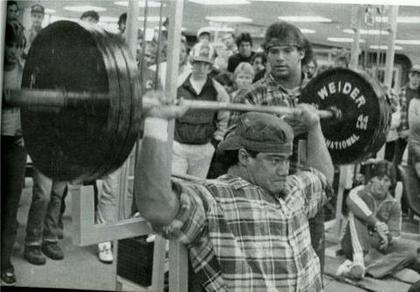
Click Here for Free Bodybuilding and Fitness Magazine Subscription
Weightlifting Techniques

The top weightlifting techniques used in bodybuilding to gain strength and build muscle mass as quickly as possible.
Choosing Your Exercises
The meat and potatoes of your routines should be big compounds that involve using a lot of muscles to move a lot of weight. Dead lifts involve using a lot of muscles to move a lot of weight. Dead Lifts, squats and bench press are the most important exercises--in that order--for packing on size. Isolation movements like [concentration curls] for biceps and [leg extensions] for quads are movements for refining the shape of muscle that are already sizeable, but they should not be the centerpieces of your routine. Think of them as side dishes.
Exercises with barbells and dumbbells tend to be more effective than machines for the simple reason that your muscles were designed to operate through certain planes of movement while working against the force of gravity. There are, however, some exercises that you simply need a machine for and that are essential in every bodybuilders routine at one point or another.
Muscular Failure
Muscular failure is the defined as the point in a set where you are no longer able to lift the weight unassisted. I take every working set to failure. If I begin a set with the intent of putting the weight down before I reach failure then it is because that set is a warm-up set.
If you consistently try to work your muscles harder than you've ever worked them before then you won't grow. Note that there is a difference between harder and longer.
Negative Reps
Advanced bodybuilders who want to add a new level of intensity to their workouts often employ a technique called negative reps at the end of a set. Once they have taken the set to failure, the spotter steps in and lifts the weight for the lifter. The lifter then lowers the weight as slowly as he or she can.
Strip Sets
Another weapon in the advanced bodybuilders' arsenal is the strip set. Once failure is reached, the spotter helps rack the weight and quickly removes some weight off the bar. Then the lifter tries to get a couple more reps. This can be repeated although I wouldn't recommend it...
Strip sets have a way of making you extremely sore. If you're looking to shake up a tired routine, this is one way to do it.
Over-Training
If you over-train, you won't grow. In fact, you risk losing muscle mass if you chronically over-train.
Over-training can be the result of a number of things. If you train too frequently and don't give your muscles enough time to repair themselves you're progress will stagnant and you'll get frustrated. If you subject yourself to two-hour marathon lifting sessions you're not going to see any growth because you're dishing out more than you can take. Steroid users can get away with these kind of lengthy workouts, but natural athletes should train smarter not longer.
Certain symptoms should be warning lights that you're over-training. Ask yourself: do you have a hard time staying awake in the middle of the day? Are you getting sick more frequently or do you have a harder than normal time shaking a cold or illness? If any of these were yes, then you need to reexamine your training schedule and allow for more rest. Going to the gym when you are tired to begin with is counterproductive. You should be tired when you leave not when you come in.
Length of a Workout
An effective workout is between 45 and 75 minutes. A few minutes of cardio followed by five to fifteen minutes of stretching then 40 to 60 minutes of actually lifting weights is all you need.
A typical workout for me consists of five or six exercises and between seven and ten working sets. All of my working sets are preceded by between one and three warm-up sets, with more emphasis on warm-up sets placed early in the workout. I take enough rest in between work sets so that my heart rate comes down and my breathing slows to near-resting levels. That's typically between two and four minutes. Rest in between warm-up sets is much shorter: never more than two minutes.
When to Train
According to an article in Muscle Media 2000 your body is best equipped for weight training three hours after you wake up and ten hours after you wake up. It has to do with when your body releases hormones.
If these times don't fit into your schedule well, I wouldn't worry about it. Really the rule thumb is, don't train when you're sleepy.
The Importance of Variety
One thing that a lot of people don't realize about weight lifting is that you need to change your routine on a regular basis to keep growing. Your muscles will get used to a particular movement or set of movements if they are always done together or always performed in the same order. To avoid this stagnation, change your workouts a bit every week. Maybe switch the order of the exercises. Or you could substitute an exercise you haven't performed in a while for one you've been doing the last month or so.
Periodization
Taking the importance of variety a step farther is the concept of periodization. A bodybuilder following this kind of schedule will gradually change the number of reps he or she performs during the work sets. For example...
Week 1 and week 2: 12 reps
Week 3 and week 4: 10 reps
Week 4 and week 6: 8 reps
Week 7 and week 8: 6 reps
subscribe to our free newsletter.
newsletter@trulyhuge.com

